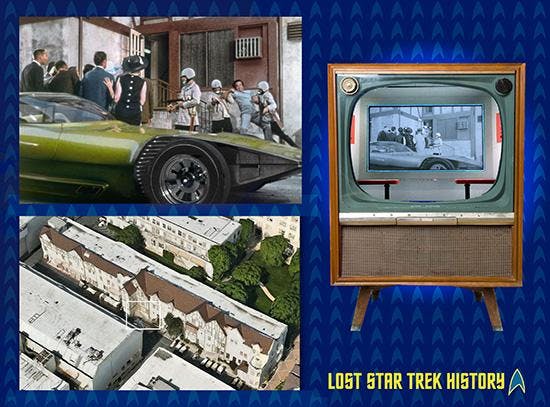Published Mar 20, 2018
"Bread and Circuses" at 50
"Bread and Circuses" at 50

Q: What is the major linkage between the Star Trek: The Original Series episode “Bread and Circuses” and Suzanne Collins’ The Hunger Games book trilogy?
A: Both of them drew inspiration from this section of Juvenal’s Satire 10:
“…iam pridem, ex quo suffragia nulli uendimus, effudit curas; nam qui dabat olim imperium, fasces, legiones, omnia, nunc secontinet atque duas tantum res anxius optat,panem et circenses. ‘perituros audio multos.’”
Huh?
OK, for all of you (including us) who are unable to read transliterated Latin, running the above through the universal translator yields this approximate conversion to Earth English:
“Now that no one buys our votes, the public has long since cast off its cares; the people that once bestowed commands, consulships, legions and all else, now meddles no more andlongs eagerly for just two things, Bread and Circuses/Games! 'I hear that many are to perish.'”
More simply, this portion of Juvenal’s work refers ominously to an elite “government” appeasing an uncaring population by appealing to its basic needs for food and morbid entertainment.
Sound familiar? It should, because it’s a major plot element of both The Hunger Games trilogy and “Bread and Circuses,” both of which essentially concern affluent citizenry selecting not-so-affluent people to fight mortally in an arena for their amusement. (Note that the name of the TOS episode, “Bread and Circuses,” comes from one popular translation of panem et circenses while the name of the nation in The Hunger Games trilogy, Panem, comes from the Latin word for bread that’s in it.)
“Bread and Circuses,” TOS’s 54th broadcast episode, was written by Gene Roddenberry and Gene L. Coon from a story by John Kneubuhl. In addition to its “what-if” plot focusing on a modern Roman culture replete with slaves, the episode also presents satirical commentary on organized religion and the television industry of the 1960’s. Since last week was the 50th anniversary of the first broadcast of this episode, we thought we’d celebrate it by doing something a little different. For this article, we thought we’d go behind the scenes and… volunteer to give tribute… to the arena and some of the places where the episode was shot.

Above: The March 9-15, 1968 TV Guide showing the listing for the premiere of “Bread and Circuses.”
Exterior Shooting at Paramount Studios
In the teaser for “Bread and Circuses,” the Enterprise learns about the fate of one of the S.S. Beagle’s crew by intercepting and watching a crude television broadcast (if we can use the colloquial term) from planet IV of system 892. When that video starts, it shows the Roman police recovering dissident, well-treated slaves.

Above: (Top left and right) The footage of the Roman police capturing the slaves was originally shot in color and then printed to black and white for insertion into the bridge’s main viewing screen. Note the car in the foreground in these shots—referred to as the Jupiter 8 in the episode—which, in real-life, was built by Gene Winfield and called the Reactor. (Bottom left) This entire sequence was filmed in front of an area known as the Dressing Room (highlighted in the white box in this modern photo) that’s located on Avenue M of the Paramount Studios lot. Incidentally, the building behind the Dressing Room, with trees around it, is the Schulberg building that doubled as the Ekosian chancellery in “Patterns of Force.”
Location Shooting at Bronson Canyon
The rocky terrain of planet 892-IV that Kirk, Spock, and McCoy beamed onto at the beginning of Act I was located in the Bronson Canyon area of Los Angeles.

Above: Exterior filming at Bronson Canyon occurred on August 12 and 13, 1967. According to the Old Farmer’s Almanac, the high temperatures for those days were 97-F and 100-F, respectively.
Sound Stage Shooting at Paramount Studios
The gladiatorial games in “Bread and Circuses,” televised to the inhabitants of 892-IV, were fought in a studio fabricated on Paramount’s stage 32.

Above: The set was decorated with assorted paraphernalia including studio television cameras (not shown here), Greek/Roman architectural elements, and Paramount/Desilu lights.

Above: (Left) The background for the arena games, shown in this bridge main viewing screen shot that used black and white footage for the optical, was a backdrop painting. (Right) The backdrop was a Paramount property that was also used in some of their other productions, including Bonanza.
And with that, we come to the end of this article and bid… valete. As one of Mr. Spock’s ancestors used to say: May the odds be ever in your favor!
Biographical Information
David Tilotta is a professor at North Carolina State University and can be contacted at david.tilotta@frontier.com. Curt McAloney—an accomplished graphic artist—resides in Minnesota and can be reached at curt@curtsmedia.com. Together, Curt and David work on startrekhistory.com. Their upcoming book, Star Trek: Lost Scenes (due out in August 2018 from Titan Books), will be filled with hundreds of carefully curated, never-before-seen color photos that they use to chronicle the making of the original series, reassemble deleted scenes left on the cutting-room floor, and showcase bloopers from the first pilot through the last episode.

